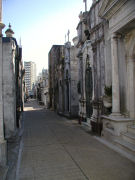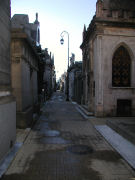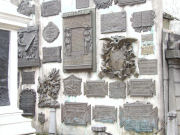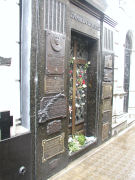 Buenos Aires – After Spanish class this morning I headed off to commune with the formerly living. Cementerio de la Recoleta is one of the most impressive cemeteries in the world. While Recoleta may be a place where a whole lot of money can buy an address, that money has little impact when it comes to taking up afterlife residence within this exclusive cloister.
Buenos Aires – After Spanish class this morning I headed off to commune with the formerly living. Cementerio de la Recoleta is one of the most impressive cemeteries in the world. While Recoleta may be a place where a whole lot of money can buy an address, that money has little impact when it comes to taking up afterlife residence within this exclusive cloister.  The Cementerio is home to the mausoleums of famed families like Alvear, Duarte, Mitre, Pueyrredón, and Sarmiento – in fact, monument after monument you will notice names that match those of local streets, plazas, galleries, and museums.
The Cementerio is home to the mausoleums of famed families like Alvear, Duarte, Mitre, Pueyrredón, and Sarmiento – in fact, monument after monument you will notice names that match those of local streets, plazas, galleries, and museums.
The cemetery is an orderly spiderweb of paving stone pathways that takes up a space roughly two city blocks on a side. In some ways it seems like walking through a scale model city, with each crypt an architectural attempt at perpetuity. At the same time, series of economic crises in Argentina have taken their toll, and many mausoleums have fallen into disrepair. I visited here briefly back in February, but it was a drizzly day and I didn’t stay long. Today I took a bit more time to wander.  This is a common stop on tours of the city, and groups appear here and there on the pathways.
This is a common stop on tours of the city, and groups appear here and there on the pathways.
Most come to see either the tomb of Domingo Sarmiento and family (he is famed for advocating and implementing a national system of education for all citizens, including the poor, minorities, and women; and for the impetus in the creation of a public library system); or, the tomb of Evita (Eva Perón).  Interestingly, initially Eva Perón was not buried here – in fact her body was spirited off to Italy for roughly 20 years before being returned, and, was only placed in Recoleta because her family, the Duartes, already had a mausoleum there. Her equally famous husband, Juan Perón, did not have enough pull to end up in Recoleta and is interred in the city’s second most famous cemetery, Chacarita (more often visited for the tomb of tango legend Carlos Gardel). There is almost always a crowd gathered around Evita’s tomb – snapping photos, touching the stone, and leaving flowers.
Interestingly, initially Eva Perón was not buried here – in fact her body was spirited off to Italy for roughly 20 years before being returned, and, was only placed in Recoleta because her family, the Duartes, already had a mausoleum there. Her equally famous husband, Juan Perón, did not have enough pull to end up in Recoleta and is interred in the city’s second most famous cemetery, Chacarita (more often visited for the tomb of tango legend Carlos Gardel). There is almost always a crowd gathered around Evita’s tomb – snapping photos, touching the stone, and leaving flowers.
Feeling the need for something a little different, despite it being a glorious day – blue skies, mid-60s – I moved on down through the surrounding park, Plaza Francia, and over to the Palais de Glace (Posadas 1725, Recoleta). This museum of contemporary national and international art tends to focus on photography, but also displays various works of sculpture, painting, and ceramics. The current exhibition is a fascinating photo collection from some of Argentina’s most famous photographers over the last century. Pictures of historical figures like Evita and Jorge Luis Borges are side-by-side with photos of the faces of poverty, of the development of various areas of the city, and of just plain daily life over the last hundred years.
[…] Henry and I spent the day out introducing Bill to some of the sights of Buenos Aires – we launched into things locally with a tour of the Cementerio de Recoleta, with the appropriate visits to the mausolea of Evita and of Domingo Sarmiento, plus a bit of a wander. Henry’s never comfortable in the cemetery, so we didn’t stay long. From there we continued on to the Centro Cultural de Recoleta, which, unfortunately, has begun a massive renovation project, and virtually all the galleries were closed to the public. That left us meandering the walkways through the artisans’ stalls in the Fería de Recoleta, and by then, of course, hungry. Henry, as per usual, loves to show off Peruvian food, and wanted to return to Zadvarie, where we’d had a delightful lunch a few months ago. We did once again, this time seated on the rooftop terrace enjoying the beautiful weather. […]
[…] Buenos Aires – Cementerio Recoleta may get all the press, it gets the tour buses, it has the surrounding touristy restaurants, the weekend artesanal fair, and, of course, the crowds that flock to gape at Evita’s tomb. It takes up a space roughly two by two city blocks, and it’s conveniently located to everything, including its attached shopping mall and cultural center. Cementerio Chacarita is at the end of a subway line (until the extension is finished, eventually), there’s an open air city bus terminal located along the main street nearby, there’s a dingy train station, and, well, let’s face it, it was created during the yellow fever epidemic of the 1800s for the common people. It takes up a space approximately nine by eight city blocks – in fact, I think Recoleta could fit into its entry plaza. […]
[…] on the left, and on the right mostly nondescript residential buildings, and finally at 1725, the Palais de Glace, built in 1880, and at various times home to an ice skating rink, the Belgrano radio station where […]